Americans’ long-standing debate over abortion has often centered on whether the procedure should be legal. But beneath the surface, there also is disagreement among U.S. adults over whether legal restrictions on abortion are an effective way to reduce the number of abortions in the United States in the first place – or whether there are other ways to do so.
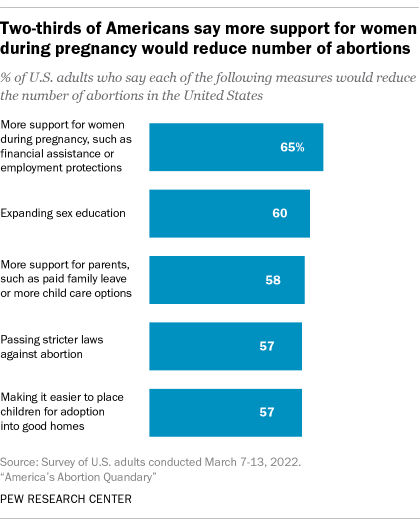
Overall, 57% of U.S. adults say passing stricter laws against abortion would “greatly” or “slightly” reduce the number of abortions in the country, according to a Pew Research Center survey conducted in March, before a draft of a Supreme Court opinion that could overturn Roe v. Wade was leaked. This is similar to the share who say providing more support for parents – such as paid family leave or more child care options – expanding sex education, and making it easier to place children for adoption into good homes would also accomplish this. A slightly higher share of adults (65%) say that more support for women during pregnancy, such as financial assistance or employment protections, would reduce the number of abortions in the U.S.
Pew Research Center conducted this study to examine attitudes about abortion in the United States. For this analysis, we surveyed 10,441 U.S. adults from March 7-13, 2022. Everyone who took part in the survey is a member of the Center’s American Trends Panel (ATP), an online survey panel that is recruited through national, random sampling of residential addresses, which gives nearly all U.S. adults a chance of selection. The survey is weighted to be representative of the U.S. adult population by gender, race, ethnicity, partisan affiliation, education and other categories. Read more about the ATP’s methodology.
Here are the questions used for this analysis, along with responses, and its methodology.
There are large gaps on some of these questions by political affiliation, age and gender. For example, two-thirds of Republicans and independents who lean toward the Republican Party say passing stricter laws against abortion would reduce the number of abortions, compared with about half of Democrats and Democratic leaners (49%). Republicans also are more likely than Democrats to say making it easier to place children for adoption into good homes would reduce the number of abortions in America (64% vs. 52%).
Conversely, Democrats are much more likely than Republicans to say expanding sex education would reduce the number of abortions (70% vs. 50%). Democrats also are more likely than their GOP counterparts to say providing more support for parents (64% vs. 53%) and providing more support for women during pregnancy (69% vs. 62%) would reduce the prevalence of abortion.
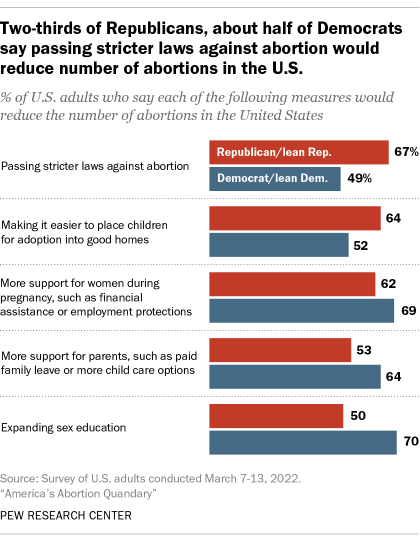
Older adults are more likely than those who are younger to say passing stricter laws against abortion would reduce the number of them that occur in the U.S., with 62% of those ages 65 and older saying this, compared with 48% of those ages 18 to 29.
Young adults are more likely to express belief in social measures being effective tools to curb the number of abortions in America. Three-quarters of Americans ages 18 to 29 (75%) say that more support for women during pregnancy would reduce the number of abortions, a view shared by 67% of those ages 30 to 49, 61% of those 50 to 64, and 59% of those ages 65 and older. Additionally, 71% of adults in this youngest age cohort (ages 18 to 29) say more support for parents – such as paid family leave or more child care options – would reduce the number of abortions in the U.S., compared with half of adults ages 50 or older who say the same. The youngest adults also are more likely than older Americans to say expanding sex education would lead to a reduction in the number of abortions in the U.S.; around seven-in-ten adults ages 18 to 29 (71%) hold this view.
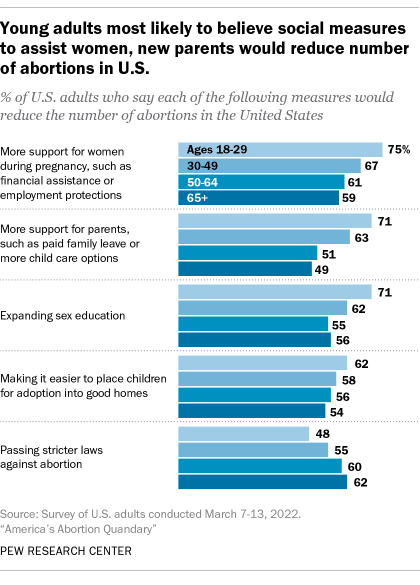
The belief that the implementation of certain social programs would reduce the number of abortions in the U.S. exists among younger adults belonging to both parties. More than seven-in-ten Democrats ages 18 to 49 (73%) say giving women more support during pregnancy would decrease the number of abortions in the U.S.; two-thirds of Republicans in this age group agree. Majorities of young adults in both parties also say that giving parents more support would reduce the number of abortions: Seven-in-ten Democrats ages 18 to 49 and roughly six-in-ten Republicans in this age group (62%) hold this view, compared with 55% of Democrats and 46% of Republicans ages 50 and older.
Gender differences on these questions are more muted than the differences by age or political affiliation. Men are notably more likely than women to say passing stricter laws against abortion would reduce the number of abortions (63% vs. 52%), but in the case of the other four measures presented to respondents, differences between men and women are modest or nonexistent.
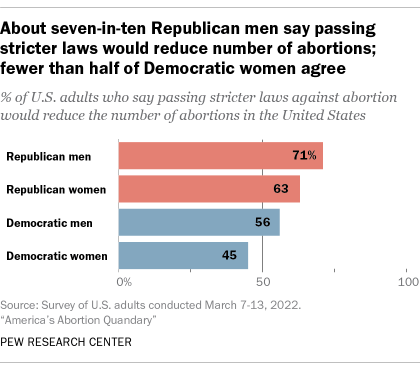
When gender is considered alongside other demographic characteristics, however, several gaps in attitudes become more pronounced. For example, Republican men (71%) are substantially more likely than Democratic women (45%) to say passing stricter laws against abortion would reduce the number of abortions in the U.S.; Republican women (63%) and Democratic men (56%) fall between these two groups on this question.
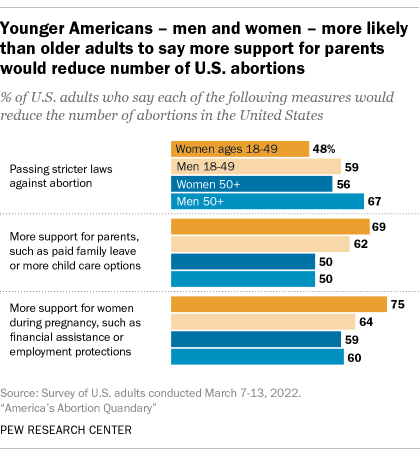
Combining gender with age shows that women under 50 are the group most likely to believe that providing more support for women during pregnancy, such as financial assistance or employment protections, would reduce the number of abortions. Three-quarters of women under 50 express this view, compared with 64% of men under 50 and around six-in-ten each among men and women ages 50 and older. Similarly, 69% of women under 50 and 62% of men under 50 say giving parents more support would reduce the number of abortions in the U.S., compared with half of older men and women who say the same.
Men ages 50 and older are considerably more likely than women under 50 to say passing stricter laws against abortion would reduce the number of abortions in the U.S. (67% vs. 48%). Men under 50 and women older than 50 fall in between these two groups on this question (59% and 56%, respectively).
Note: Here are the questions used for this analysis, along with responses, and its methodology.
